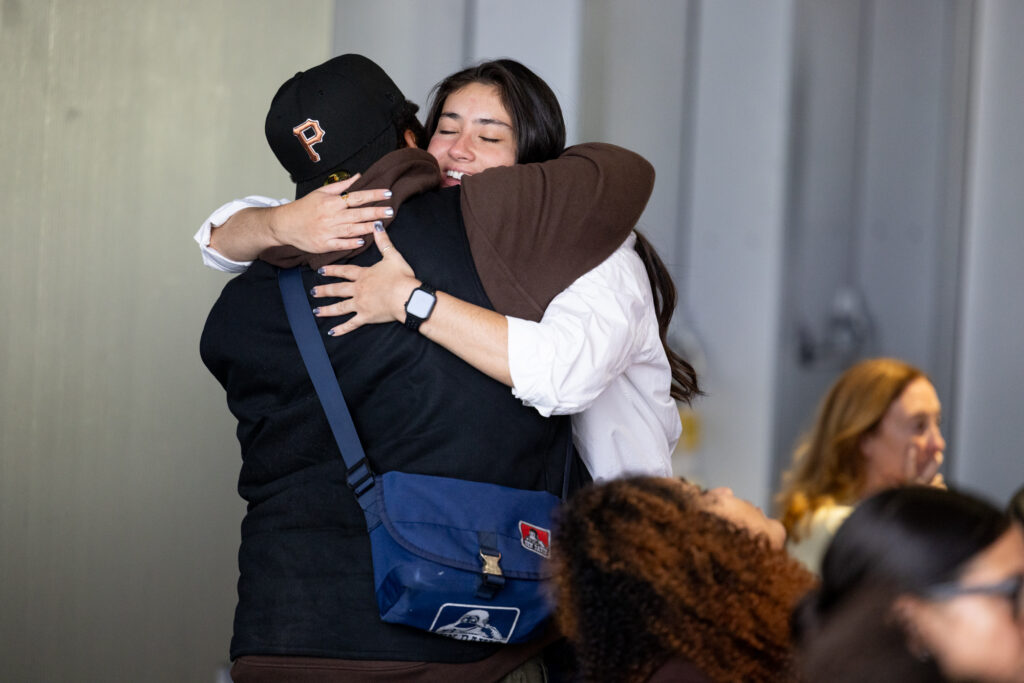On September 30, 2025, Foster America hosted the second annual Fostering Futures Forum at the MIT Media Lab. Celebrating imagination, collaboration, and the power of lived experience, the Forum spotlighted the Technology Leadership Circle (TLC) — a 10-month fellowship uniting changemakers with lived experience in foster care and MIT collaborators to co-design digital concepts that advance wellbeing and belonging.

Over the course of the fellowship, fifteen fellows worked alongside TLC faculty to create five early-stage concepts — Goal Booster, Transit Central, Foster Files, Care 2 Connect, and Community Gaming — each offering a new way to reduce harm and strengthen connection for youth in foster care. The Forum brought together more than 100 attendees—a mix of MIT professors and students, lived experts, child-welfare practitioners, philanthropists, and social-sector leaders to explore how empathy and technology can intersect to create tools that restore agency and connection for youth in foster care.
“When I think about what I’m taking away from this experience, it’s the importance of including others — the community, the people impacted, and those working in these systems every day. When you bring all those voices together and value every perspective, you can create phenomenal things.” — Tayvon Lewis, TLC Fellow
The day began with a warm welcome from Dr. Rosalind Picard, Director of the Affective Computing group at the MIT Media Lab, and Marie Zemler Wu, Co-Founder and Executive Director of Foster America, who framed the urgency and opportunity to redesign systems so families can stay together and thrive. They were joined by Jessica Rosenworcel, Executive Director of the MIT Media Lab, who emphasized the Lab’s commitment to interdisciplinary collaboration and the power of technology to advance human wellbeing. Together, they set the stage for a day centered on empathy, equity, and innovation.
Each TLC concept reflected a distinct approach to reimagining technology as a tool for care and connection:
“This wasn’t just talk—it was real teams, real MIT technologists, and real lived-experience experts working side by side to create important solutions. I walked away more inspired, more connected, and more equipped to continue building.” —Takkeem Morgan, Senior Communications Director at Prevent Child Abuse America; Foster America Board Member
Two panels anchored the day’s discussions, grounding the creative work in broader conversations about equity, prevention, and practice.
The opening panel, Background & Brightspots: Bringing Together Lived Experience, Child Welfare Change, and Advanced Technology, featured Rebecca Jones Gaston (former ACYF Commissioner and founder of RJG Consulting), J. Phillip Thompson (MIT Professor of Urban Studies and Planning at MIT and former NYC Deputy Mayor), and Sofie Fashana (Policy Entrepreneur at Next100 and Foster America Fellow). Together, they explored how people and policy can support prevention-focused reforms that keep families together, advance racial equity, and promote care systems built on dignity and belonging.
The second panel, From Prototype to Practice: Building Tech That Public Systems Can Use, brought together Deb Roy (MIT Professor of Media Arts and Sciences, Director of MIT’s Center for Constructive Communication, and CEO of Cortico), Christina Haines (Chief Strategy Officer at Silver Lining Mentoring), Molly Tierney (Managing Director at Accenture), and Michael Tanana (Co-Founder and CTO at Lyssn). Each shared how technology can amplify empathy and strengthen human connection in public systems — from AI tools that help agencies listen and learn from lived experience, to secure platforms that sustain mentoring relationships, to virtual-reality learning that builds skill and reflection among frontline staff. Together, they demonstrated how technology can serve as an ally in reimagining care, not a replacement for it.
“This event was unique. Bringing technologists together with people who have lived experience in the system created something powerful and rare. Seeing lived experts lead the design process and shape solutions from their own ideas — that’s what will truly move the field forward.” — Michael Tanana, Co-Founder and CTO, Lyssn
What made the 2025 Forum remarkable wasn’t just the ideas — it was the collaboration. Fellows, researchers, academic faculty, and collaborators didn’t meet in parallel lanes; they worked in concert, co-designing technology as a form of care, agency, and empowerment for foster youth. The energy in the room was equal parts innovation lab and community circle — a living example of what’s possible when ideas and people with diverse experiences come together to imagine something different.
“So very glad to have joined a rich panel discussion about all the ways technology can break down barriers in child welfare. We can use it to keep children home, bring them home, and tell the story of what it takes to do right by families in this country.” — Molly McGrath-Tierny, Managing Director at Accenture
The Fostering Futures Forum continues to grow in both scope and depth, demonstrating what’s possible when lived-experience leaders are not the subjects of innovation, but its architects — creating tools that help young people not just navigate systems, but reshape them.

Additional photos from the event can be found here.